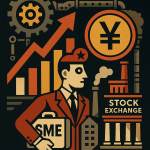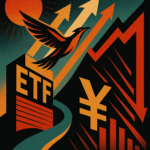Key Points
- The Guangzhou Futures Exchange (GFE) (广期所) implemented a “four-arrow” strategy on July 23, 2025, to curb soaring prices and volatility in industrial silicon, polysilicon, and lithium carbonate futures.
- The “four-arrow” strategy includes adjustments to daily price limits, trading margin requirements, transaction fee standards, and trading limits, effective July 25, 2025.
- Polysilicon futures experienced extreme volatility, hitting a new all-time high and gaining over 50% since early July before the GFE’s intervention.
- Other commodities reacted differently, with industrial silicon futures closing up 0.58% and lithium carbonate futures closing down 4.07% on July 23, 2025.
- The GFE emphasized that the stricter rule applies where new regulations conflict with existing ones, signaling a firm stance against market speculation.

The Guangzhou Futures Exchange (GFE) (Guangqi Suo 广期所) just dropped the hammer on soaring futures prices, signaling a major move to cool down a red-hot market.
Here’s what’s going on.
A market-wide “anti-involution” push has been gaining steam, lighting a fire under several bulk commodities.
This has cranked up the volatility on key futures contracts, and the GFE is stepping in to manage the risk.
On the evening of July 23, 2025, they rolled out a “four-arrow” strategy to hit the brakes.
The targets? Industrial silicon, polysilicon, and lithium carbonate futures.
GFE’s “Four-Arrow” Strategy to Cool the Market
The Guangzhou Futures Exchange is getting serious about taming market volatility.
They’re making targeted adjustments across four key areas:
- Daily price limits
- Trading margin requirements
- Transaction fee standards
- Trading limits
Let’s break down exactly what’s changing.
Deep Dive: The New Trading Regulations
These new rules are designed to curb speculation and bring some stability back to the market.
1. Industrial Silicon Futures Adjustments:
Starting from the settlement on July 25, 2025:
- The daily price limit is now capped at 8%.
- Speculative trading margin requirements are hiked to 10%.
- Hedging trading margin requirements are set at 9%.
2. Higher Transaction Fees:
Effective July 25, 2025, get ready for new fees:
- Industrial Silicon (SI2509): Fees adjusted to 0.025% of the transaction value. This applies to intraday closing-out trades, too.
- Polysilicon (PS2509): Fees jump to 0.04% of the transaction value, including for intraday closing-out.
- Lithium Carbonate (LC2509): Fees are now 0.016% of the transaction value, with the same rule for intraday closing-out.
3. New Single-Day Opening Limits:
Also kicking in on July 25, 2025, non-futures company members and clients face new daily caps:
- Industrial Silicon (SI2509): Limit of 3,000 lots per day.
- Polysilicon (PS2509): Limit of 3,000 lots per day.
A quick note on this: This limit is the total of buy-to-open and sell-to-open positions in a single day.
Important exemptions: Hedging and market-making trades are not subject to these limits.
And if you’ve got accounts with actual control relationships? They’ll be treated as a single account under these rules.
The GFE’s Official Stance: The Stricter Rule Applies
The GFE made it clear: if these new rules on price limits and margin standards conflict with any existing ones, the stricter—meaning higher—of the two will be enforced.
No wiggle room here.

Resume Captain
Your AI Career Toolkit:
- AI Resume Optimization
- Custom Cover Letters
- LinkedIn Profile Boost
- Interview Question Prep
- Salary Negotiation Agent

Market Reaction: A Volatility Rollercoaster
So, how did the market react to all this? In a word: wildly.
The “anti-involution” trend has put a massive spotlight on polysilicon futures, a key raw material for photovoltaic (PV) cells.
This commodity has been leading the charge.
- July 22: The main polysilicon futures contract rocketed up, hitting its upper daily price limit.
- July 23: It did it again, rallying hard in the morning and smashing past the ¥50,000 RMB ($6,890 USD) mark.
But the rally didn’t hold. The price limit was breached, and crazy intraday volatility followed.
By the close, the main polysilicon futures contract settled at ¥50,080 RMB/ton ($6,903 USD/ton), up 5.50%.
This wasn’t just another good day; it was a new all-time high since its listing, marking a mind-blowing gain of over 50% since the beginning of July.
How Other Key Commodities Fared
- Polysilicon Futures (PS2509): Settled at ¥50,080 RMB/ton ($6,903 USD/ton). Up 5.50%. Achieved a new all-time high, gaining over 50% since early July.
- Industrial Silicon Futures (SI2509): Closed up 0.58% after an intraday surge of over 5%.
- Lithium Carbonate Futures (LC2509): Closed down 4.07%. Settled at ¥69,380 RMB/ton ($9,561 USD/ton) after dropping below ¥70,000 RMB.
The other two major players in the PV industry also had a wild ride on July 23.
Industrial Silicon Futures:
Saw an intraday surge of over 5% but ended up closing just 0.58% higher.
Lithium Carbonate Futures:
This one had a rougher day. It closed down 4.07%.
After hitting a high of ¥74,680 RMB/ton ($10,296 USD/ton), it dropped below the ¥70,000 RMB ($9,646 USD) level, settling at ¥69,380 RMB/ton ($9,561 USD/ton).

Expert Insight: The Lithium Carbonate Puzzle
Analysts at Hualian Futures weighed in on the lithium carbonate situation.
They note that recent price stabilization is mostly thanks to cost support from rising lithium ore prices and increased supply.
However, the core issue—the 供需矛盾 (gōngxū máodùn), or supply-and-demand contradiction—remains severe.
Basically, both supply and demand are expected to rise, but massive inventories are proving tough to clear out, keeping a lid on prices.
Recent policy impacts, like the ones from the GFE, are only adding to the significant market fluctuations.
It’s a clear signal that regulators are watching closely, and the actions of the Guangzhou Futures Exchange (GFE) will continue to be a major factor for investors and traders in this space.

Find Top Talent on China's Leading Networks
- Post Across China's Job Sites from $299 / role, or
- Hire Our Recruiting Pros from $799 / role
- Qualified Candidate Bundles
- Lower Hiring Costs by 80%+
- Expert Team Since 2014
Your First Job Post





